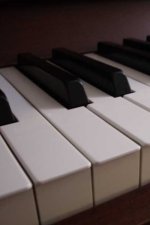
In an acoustic piano, the sound is created by mechanical hammers striking strings, causing them to vibrate. As a result of centuries of development, its keys are now made in such a way that the pianist has much control over the resulting sound, and a vast range of sounds can be made.
"Keyboard" (electronic organ etc.) keys only switch tone on and the sound is mainly controlled by a set of toggle or slide switches. These switches allow to change over to different instruments (or noises), control colour of tone, change automatic accompanient and so on. More complex (and costly) keyboards offer a greater range of these features but all of them are generally only "on/off" features and the number of usable combinations is limited.
"Electronic piano" or "Touch sensitive keyboard" or "weighted action" mimics to some degree the mechanical piano's ability to control sound. It costs much more than common keyboards, some of them more than an acoustic piano. They usually offer only a few different instrument sounds (eg PIANO1, PIANO2, ELECTRONIC PIANO). They still offer less control over sound than mechanical piano and resulting sound is usually not as pleasant, less rich.
Acoustic piano is generally needed in preparation for exams. It
is
not
advisable to prepare for practical examinations on keyboard instead of
on piano, as keyboard playing doesn't develop touch quality needed for
good results at examinations. For the lower grades an electronic piano
is an option, but it will be a disadvantage as the student is required
to play on an
acoustic piano at the exam.
Standard piano has 88 keys. Keyboards with 88 keys are good. Anything with less than 76 keys is pretty much useless - some pieces cannot be played.
Beginners can even use a keyboard as long as the keys are the
same
width as on an acoustic piano, but they are likely to develop some bad
habits - simplistic response of the keyboard does not provide sufficient
feedback.
Keyboards with narrow keys and/or with any non-standard
keyboard
layout are toys only. They cannot be used for serious work.
Another important issue is point of view of Australian Music Examinations Board :
http://www.ameb.edu.au/content/digital-pianos-vs-acoustic-pianos
... Many people have trouble deciding between buying a good digital
piano or an acoustic piano for their student who may be starting to
learn piano....
... AMEB encourages candidates to use acoustic pianos to prepare for exams...
... For AMEB, digital pianos should meet these specifications:
Keyboard size - 88 notes
Action - weighted and touch sensitive
Pedals - fixed, and functioning as for acoustic pianos
....